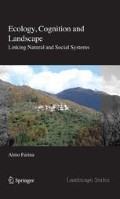Abstract
Whether viewing our planet from space or simply viewing the structure of soil we observe objects spatially arranged as mosaics. The mosaic seems to be the common pattern that we perceive, especially from an aerial view.
Access this chapter
Tax calculation will be finalised at checkout
Purchases are for personal use only
References
Borman, F.H. and Lickens, G.E. 1979. Pattern and process in a forest ecosystem. Springer-Verlag, New York.
Golley, F. 1993. A history of the ecosystem concept. Yale University Press, New Haven.
Hutchings, M.J., John, E.A., and Stewart, A.J.A. 2000. The ecological consequences of environmental heterogeneity. Blackwell Science, London.
Johst, K.J., Brandl, R., and Pfeifer, R. 2001. Foraging in a patchy and dynamic landscape: Human land use and the white stork. Ecological Applications 11: 60–69.
Kolasa, J. and Pickett, S.T.A. (eds.) 1991. Ecological heterogeneity. Springer-Verlag, New York.
Kolasa, J. and Rollo, C.D. 1991. 1. Introduction: The Heterogeneity of heterogeneity: A glossary. In: Kolasa, J. and Pickett, S.T.A. (eds.), Ecological heterogeneity. Springer-Verlag, New York, pp. 1–23.
Levin, S.A. 1976. Population dynamic models in heterogeneous environments. Annual Review of Ecology and Systematics 7: 287–310.
Pulliam, R. 1988. Sources-sinks, and population regulation. American Naturalist 132: 652–661.
Pulliam, R. 1996. Sources and sinks: Empirical evidence and population consequences. In: Rhodes, O.E., Chesser, R.K., and Smith, M.H. (eds.), Population dynamics in ecological space and time. The University of Chicago Press, Chicago, pp. 45–69.
Remmert, H. 1989. Okologie. Springer-Verlag, Berlin.
Remmert, H. 1991. The mosaic-cycle concept of ecosystems – An overview. In: Remmert, H. (ed.), The mosaic-cycle concept of ecosystems. Springer-Verlag, Berlin, pp. 1–21.
Tansley, A.G, 1935. The use and abuse of vegetational concepts and terms. Ecology 16: 284–307.
Watkinson, A.R. and Sutherland, W.J. 1995. Sources, sinks and pseudo-sinks. Journal of Animal Ecology 64: 126–30.
Wiens, J. 2000. Ecological heterogeneity: an ontogeny of concepts and approaches. In: Hutchings M.J., John E.A., and Stewart A.J.A. (eds.), The ecological consequences of environmental heterogeneity, Blackwell Science, Oxford, pp. 9–31.
Author information
Authors and Affiliations
Corresponding author
Rights and permissions
Copyright information
© 2009 Springer Science+Business Media B.V.
About this chapter
Cite this chapter
Farina, A. (2009). Toward a Theory of the Mosaic. In: Ecology, Cognition and Landscape., vol 11. Springer, Dordrecht. https://doi.org/10.1007/978-90-481-3138-9_3
Download citation
DOI: https://doi.org/10.1007/978-90-481-3138-9_3
Published:
Publisher Name: Springer, Dordrecht
Print ISBN: 978-90-481-3137-2
Online ISBN: 978-90-481-3138-9
eBook Packages: Biomedical and Life SciencesBiomedical and Life Sciences (R0)

